247 scholarly books by University Press of New England and 15
start with D
247 scholarly books by University Press of New England and 15
247 scholarly books by University Press of New England
15 start with D start with D
15 start with D start with D
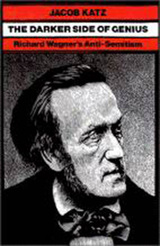
The Darker Side of Genius
Richard Wagner’s Anti-Semitism
Jacob. Katz
University Press of New England, 2002
For some, Richard Wagner is infamous as the favorite composer of Hitler, who seems to have admired Wagner as an early exponent of his own racist ideology and worldview. Impressed by this assumption victims of Hitler have also associated Wagner and his music with Nazism to such an extent that in Israel a ban on public performance of that music is upheld to this day. Jacob Katz, a scholar of international repute, approaches the highly charged issue of Richard Wagner’s anti-Semitism with the tools of a critical historian, asking two central questions: What role did anti-Semitism play in the life and work of Richard Wagner? And how did his anti-Jewish thoughts and sentiments contribute to the development of political anti-Semitism and Nazism? In this first comprehensive and judicious treatment of Wagner’s anti-Semitism, Katz analyzes the composer’s attitudes in their own time and place and in the context of Wagner’s life and aspirations. He traces Wagner’s feelings toward Jews chronologically, showing that the composer was ultimately obsessed by a deep-seated Judeophobia generated by conflict with his Jewish mentors and competitors. But he argues against reading the later emergence of Nazism back into Wagner’s life and work. While not absolving Wagner from responsibility for his views, Katz contends that contemporary Jews have paradoxically and uncritically adopted the Nazis’ assumptions about Wagner. Katz argues that Wagner’s music is untainted by his anti-Semitism, that there is, in fact, very little in Wagner’s art that, without forced speculation, can be related to his racist views.
[more]
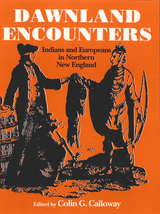
Dawnland Encounters
Indians and Europeans in Northern New England
Edited by Colin G. Calloway
University Press of New England, 1991
Colin G. Calloway collects, for the first time, documents describing the full range of encounters of Indians and Europeans in northern New England during the Colonial era. His comprehensive and highly readable introduction to the subject of Indian and European interaction in northern New England covers early encounters, missionary efforts, diplomacy, war, commerce, and cultural interchange and features a wide range of primary sources, including narratives, letters, account books, treaties, and council proceedings. Together with period illustrations, the documents testify to the richness and variety of the inter-ethnic relations in northern New England. They also show that while conflict certainly occurred, the encounters were also marked by cooperation and accommodation.
[more]
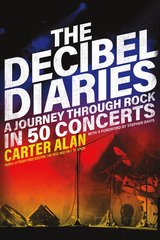
The Decibel Diaries
A Journey through Rock in 50 Concerts
Carter Alan
University Press of New England, 2017
Sometimes a rock concert is more than just an event. Every so often a band’s performance becomes a musical milestone, a cultural watershed, a political statement, and a personal apotheosis. On any given night a rock concert can tell the truth about who we are, where we are, and what’s going on in music and life right now. In The Decibel Diaries, Carter Alan, longtime DJ and music director at WZLX in Boston, chronicles a lifetime in rock with a tour through fifty concerts that defined such moments—from Crosby, Stills, Nash & Young playing in the rain when Richard Nixon resigned to Talking Heads and the first stirrings of punk in the basement bars of New York and Boston to the bluegrass angel Alison Krauss and the adaptable veteran Robert Plant forging a plangent, plaintive postmodern synergy. For each event Alan shows us what it was like to be there and telescopes out to reveal how this show fit into the arc of the artist’s career, the artist’s place in music, and the music’s place in the wider world. Taken together, The Decibel Diaries is a visceral and visionary portrait of nearly fifty years of rock ’n’ roll.
[more]
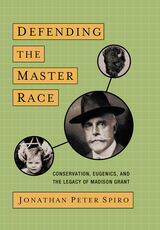
Defending the Master Race
Conservation, Eugenics, and the Legacy of Madison Grant
Jonathan Spiro
University Press of New England, 2008
Scholars have labeled Madison Grant everything from the “nation’s most influential racist” to the “greatest conservationist that ever lived.” His life illuminates early twentieth-century America as it was heading toward the American Century, and his legacy is still very much with us today, from the speeches of immigrant-bashing politicians to the international efforts to arrest climate change. This insightful biography shows how Grant worked side-by-side with figures such as Theodore Roosevelt to found the Bronx Zoo, preserve the California redwoods, and save the American bison from extinction. But Grant was also the leader of the eugenics movement in the United States. He popularized the infamous notions that the blond-haired, blue-eyed Nordics were the “master race” and that the state should eliminate members of inferior races who were of no value to the community. Grant’s behind-the-scenes machinations convinced Congress to enact the immigration restriction legislation of the 1920s, and his influence led many states to ban interracial marriage and sterilize thousands of “unworthy” citizens. Although most of the relevant archival materials on Madison Grant have mysteriously disappeared over the decades, Jonathan Spiro has devoted many years to reconstructing the hitherto concealed events of Grant’s life. His astonishing feat of detective work reveals how the founder of the Bronx Zoo wound up writing the book that Adolf Hitler declared was his “bible.”
[more]
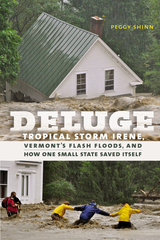
Deluge
Tropical Storm Irene, Vermont’s Flash Floods, and How One Small State Saved Itself
Peggy Shinn
University Press of New England, 2013
On August 28, 2011, after pounding the Caribbean and the U.S. Eastern seaboard for more than a week, Hurricane Irene finally made landfall in New Jersey. As the storm headed into New England, it was quickly downgraded to a tropical storm. And by Sunday afternoon, national news outlets were giving postmortems on the damage. Except for some flooding in low-lying areas, New York City—Irene’s biggest target—had escaped its worst-case scenario. Story over. But the story wasn’t over. As Irene’s eye drifted north, its bands of heavy rains twisted westward over Vermont’s Green Mountains. The mountains forced these bands upward, wringing the rain out of them like water from a sponge. Streams and rivers were transformed into torrents of brown water and debris, gouging mountainsides, reshaping valleys, washing out roads, pulling apart bridges, and carrying away homes, livestock, and automobiles. For weeks, mountain towns were isolated, with no way in or out, and thousands of people were left homeless. In the immediate aftermath of the disaster, it fell on the shoulders of ordinary Vermonters to help victims and rebuild the state. Deluge is the complete story of the floods, the rescue, and the recovery, as seen through the eyes of the people who lived through them: Wilmington’s Lisa Sullivan, whose bookstore was flooded, and town clerk Susie Haughwout, who saved the town records; Tracy Payne, who lost her home in Jamaica—everything in it, and the land on which it sat; Geo Honigford in South Royalton, who lost his crops, but put his own mess on hold to help others in the town; the men who put U.S. Route 4 back together at breakneck speed; and the entire village of Pittsfield, completely isolated after the storm, and its inspirational story of real community.
[more]

The Devil’s Cormorant
A Natural History
Richard J. King
University Press of New England, 2014
Behold the cormorant: silent, still, cruciform, and brooding; flashing, soaring, quick as a snake. Evolution has crafted the only creature on Earth that can migrate the length of a continent, dive and hunt deep underwater, perch comfortably on a branch or a wire, walk on land, climb up cliff faces, feed on thousands of different species, and live beside both fresh and salt water in a vast global range of temperatures and altitudes, often in close proximity to man. Long a symbol of gluttony, greed, bad luck, and evil, the cormorant has led a troubled existence in human history, myth, and literature. The birds have been prized as a source of mineral wealth in Peru, hunted to extinction in the Arctic, trained by the Japanese to catch fish, demonized by Milton in Paradise Lost, and reviled, despised, and exterminated by sport and commercial fishermen from Israel to Indianapolis, Toronto to Tierra del Fuego. In The Devil’s Cormorant, Richard King takes us back in time and around the world to show us the history, nature, ecology, and economy of the world’s most misunderstood waterfowl.
[more]
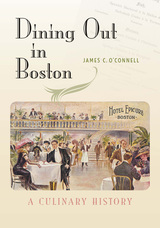
Dining Out in Boston
A Culinary History
James C. O'Connell
University Press of New England, 2016
Over the years, Boston has been one of America’s leading laboratories of urban culture, including restaurants, and Boston history provides valuable insights into American food ways. James C. O’Connell, in this fascinating look at more than two centuries of culinary trends in Boston restaurants, presents a rich and hitherto unexplored side to the city’s past. Dining Out in Boston shows that the city was a pioneer in elaborate hotel dining, oyster houses, French cuisine, student hangouts, ice cream parlors, the twentieth-century revival of traditional New England dishes, and contemporary locavore and trendy foodie culture. In these stories of the most-beloved Boston restaurants of yesterday and today—illustrated with an extensive collection of historic menus, postcards, and photos—O’Connell reveals a unique history sure to whet the intellectual and nostalgic appetite of Bostonians and restaurant-goers the world over.
[more]
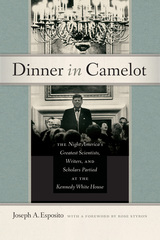
Dinner in Camelot
The Night America's Greatest Scientists, Writers, and Scholars Partied at the Kennedy White House
Joseph A. Esposito
University Press of New England, 2018
In April 1962, President and Mrs. John F. Kennedy hosted forty-nine Nobel Prize winners—along with many other prominent scientists, artists, and writers—at a famed White House dinner. Among the guests were J. Robert Oppenheimer, who was officially welcomed back to Washington after a stint in the political wilderness; Linus Pauling, who had picketed the White House that very afternoon; William and Rose Styron, who began a fifty-year friendship with the Kennedy family that night; James Baldwin, who would later discuss civil rights with Attorney General Robert Kennedy; Mary Welsh Hemingway, Ernest Hemingway’s widow, who sat next to the president and grilled him on Cuba policy; John Glenn, who had recently orbited the earth aboard Friendship 7; historian Arthur M. Schlesinger, Jr., who argued with Ava Pauling at dinner; and many others. Actor Frederic March gave a public recitation after the meal, including some unpublished work of Hemingway’s that later became part of Islands in the Stream. Held at the height of the Cold War, the dinner symbolizes a time when intellectuals were esteemed, divergent viewpoints could be respectfully discussed at the highest level, and the great minds of an age might all dine together in the rarefied glamour of “the people’s house.”
[more]
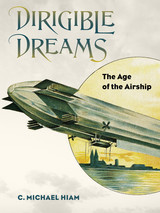
Dirigible Dreams
The Age of the Airship
C. Michael Hiam
University Press of New England, 2014
Here is the story of airships—manmade flying machines without wings—from their earliest beginnings to the modern era of blimps. In postcards and advertisements, the sleek, silver, cigar-shaped airships, or dirigibles, were the embodiment of futuristic visions of air travel. They immediately captivated the imaginations of people worldwide, but in less than fifty years dirigible became a byword for doomed futurism, an Icarian figure of industrial hubris. Dirigible Dreams looks back on this bygone era, when the future of exploration, commercial travel, and warfare largely involved the prospect of wingless flight. In Dirigible Dreams, C. Michael Hiam celebrates the legendary figures of this promising technology in the late nineteenth and early twentieth centuries—the pioneering aviator Alberto Santos-Dumont, the doomed polar explorers S. A. Andrée and Walter Wellman, and the great Prussian inventor and promoter Count Ferdinand von Zeppelin, among other pivotal figures—and recounts fascinating stories of exploration, transatlantic journeys, and floating armadas that rained death during World War I. While there were triumphs, such as the polar flight of the Norge, most of these tales are of disaster and woe, culminating in perhaps the most famous disaster of all time, the crash of the Hindenburg. This story of daring men and their flying machines, dreamers and adventurers who pushed modern technology to—and often beyond—its limitations, is an informative and exciting mix of history, technology, awe-inspiring exploits, and warfare that will captivate readers with its depiction of a lost golden age of air travel. Readable and authoritative, enlivened by colorful characters and nail-biting drama, Dirigible Dreams will appeal to a new generation of general readers and scholars interested in the origins of modern aviation.
[more]
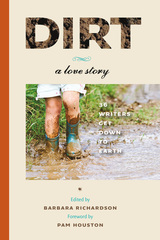
Dirt
A Love Story
Edited by Barbara Richardson
University Press of New England, 2015
Community farms. Mud spas. Mineral paints. Nematodes. The world is waking up to the beauty and mystery of dirt. This anthology celebrates the Earth’s generous crust, bringing together essays by award-winning scientists, authors, artists, and dirt lovers to tell dirt’s exuberant tales. Geographically broad and topically diverse, these essays reveal life as lived by dirt fanatics—admiring the first worm of spring, taking a childhood twirl across a dusty Kansas farm, calculating how soil breathes, or baking mud pies. Essayists build a dirt house, center a marriage around dirt, sink down into marshy heaven, and learn to read dirt’s own language. Scientists usher us deep underground with the worms and mycorrhizae to explore the vast and largely ignored natural processes occurring beneath our feet. Whether taking a trek to Venezuela to touch the oldest dirt in the world or reveling in the blessings of our own native soils, these muscular essays answer the important question: How do you get down with dirt? A literary homage to dirt and its significance in our lives, this book will interest hikers, gardeners, teachers, urbanites, farmers, environmentalists, ecologists, and others intrigued by our planet’s alluring skin. Essayists include Vandana Shiva, Peter Heller, Janisse Ray, Bernd Heinrich, Linda Hogan, Wes Jackson, BK Loren, David Montgomery, Laura Pritchett, and Deborah Koons Garcia.
[more]
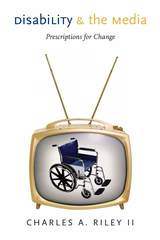
Disability and the Media
Prescriptions for Change
Charles A. Riley
University Press of New England, 2005
In the past decade, the mass media discovered disability. Spurred by the box-office appeal of superstars such as the late Christopher Reeve, Michael J. Fox, Stephen Hawking, and others, and given momentum by the success of Oscar-winning movies, popular television shows, best-selling books, and profitable websites, major media corporations have reversed their earlier course of hiding disability, bringing it instead to center stage. Yet depictions of disability have remained largely unchanged since the 1920s. Focusing almost exclusively on the medical aspect of injury or illness, the disability profile in fact and fiction leads inevitably to an inspiring moment of “overcoming.” According to Riley, this cliché plays well with a general audience, but such narratives, driven by prejudice and pity, highlight the importance of “fixing” the disability and rendering the “sufferer” as normal as possible. These stories are deeply offensive to persons with disabilities. Equally important, misguided coverage has adverse effects on crucial aspects of public policy, such as employment, social services, and health care. Powerful and influential, the media is complicit in this distortion of disability issues that has proven to be a factor in the economic and social repression of one in five Americans. Newspapers and magazines continue to consign disability stories to the “back of the book” health or human-interest sections, using offensive language that has long been proscribed by activists. Filmmakers compound the problem by featuring angry misfits or poignant heroes of melodramas that pair love and redemption. Publishers churn out self-help titles and memoirs that milk the disability theme for pathos. As Riley points out, all branches of the media are guilty of the same crude distillation of the story to serve their own, usually fiscal, ends. Riley’s lively inside investigation illuminates the extent of the problem while pinpointing how writers, editors, directors, producers, filmmakers, advertisers and the executives who give their marching orders go wrong, or occasionally get it right. Through a close analysis of the technical means of representation, in conjunction with the commentary of leading voices in the disability community, Riley guides future coverage to a more fair and accurate way of putting the disability story on screen or paper. He argues that with the “discovery” by Madison Avenue that the disabled community is a major consumer niche, the economic rationale for more sophisticated coverage is at hand. It is time, says Riley, to cut through the accumulated stereotypes and find an adequate vocabulary that will finally represent the disability community in all its vibrant and fascinating diversity.
[more]
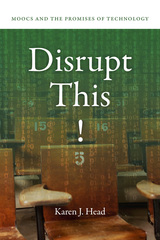
Disrupt This!
MOOCs and the Promises of Technology
Karen J. Head
University Press of New England, 2017
In this smart and incisive work, Karen J. Head describes her experience teaching a Massive Open Online Course (MOOC) and the attendant pressure on professors, especially those in the humanities, to embrace new technologies in the STEM era. And yet, as she argues, MOOCs are just the latest example of the near-religious faith that some universities have in the promise of technological advances. As a teacher of rhetoric, Head is well versed at sniffing out the sophistry embedded in the tech jargon increasingly rife in the academy. Disrupt This! is a broader-based critique of the promises of technological “disruption” and the impact of Silicon Valley thinking on an unsuspecting, ill-prepared, and often gullible university community grasping for relevance, while remaining in thrall to the technologists.
[more]

A Documentary History of Communism in Russia
From Lenin to Gorbachev
Edited by Robert V. Daniels
University Press of New England, 2001
An extensive revision of the valued but unobtainable 1960 edition. Nearly 300 key documents are now readily available in translation.
[more]

Dog Whistles, Walk-Backs, and Washington Handshakes
Decoding the Jargon, Slang, and Bluster of American Political Speech
Chuck McCutcheon and David Mark
University Press of New England, 2014
To the amusement of the pundits and the regret of the electorate, our modern political jargon has become even more brazenly two-faced and obfuscatory than ever. Where once we had Muckrakers, now we have Bed-Wetters. Where Blue Dogs once slept peaceably in the sun, Attack Dogs now roam the land. During election season—a near constant these days—the coded rhetoric of candidates and their spin doctors, and the deliberately meaningless but toxic semiotics of the wing nuts and backbenchers, reach near-Orwellian levels of self-satisfaction, vitriol, and deceit. The average NPR or talk radio listener, MSNBC or Fox News viewer, or blameless New York Times or Wall Street Journal reader is likely to be perplexed, nonplussed, and lulled into a state of apathetic resignation and civic somnolence by the rapid-fire incomprehensibility of political pronouncement and commentary—which is, frankly, putting us exactly where the pundits want us. Dog Whistles, Walk-Backs, and Washington Handshakes is a tonic and a corrective. It is a reference and field guide to the language of politics by two veteran observers that not only defines terms and phrases but also explains their history and etymology, describes who uses them against whom, and why, and reveals the most telling, infamous, amusing, and shocking examples of their recent use. It is a handbook of lexicography for the Wonkette and This Town generation, a sleeker, more modern Safire’s Political Dictionary, and a concise, pointed, bipartisan guide to the lies, obfuscations, and helical constructions of modern American political language, as practiced by real-life versions of the characters on House of Cards.
[more]
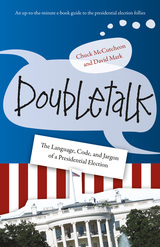
Doubletalk
The Language, Code, and Jargon of a Presidential Election
Chuck McCutcheon and David Mark
University Press of New England, 2016
The only time most Americans care anything about politics is during the presidential election cycle. This quadrennial flood of posturing and blame, once confined to the July conventions and the November election, has spread like a greasy lake across the landscape and calendar of our politics. From the first exploratory rumblings of the hopefuls sometime after the midterm elections to the tsunami of Super Tuesday, the political language of the presidential election has become a reflecting pool of our polity. Doubletalk casts a warm ray of sunlight on the campaign trail as an add-on to last year’s Dog Whistles, Walk-backs, and Washington Handshakes, with over 100 new terms, phrases, and epithets combining wit, humor, truth, and dubious taste and propriety.
[more]
READERS
Browse our collection.
PUBLISHERS
See BiblioVault's publisher services.
STUDENT SERVICES
Files for college accessibility offices.
UChicago Accessibility Resources
home | accessibility | search | about | contact us
BiblioVault ® 2001 - 2024
The University of Chicago Press









